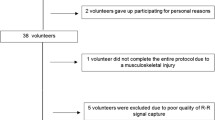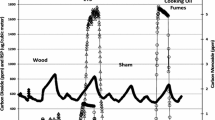Abstract
Ten normal adult tobacco smokers and 10 non-smoking volunteers 20–31 years of age were the subjects of this study. The tobacco smokers all had a history of daily tobacco smoking. They were asked to stop smoking for 12 hours prior to testing. The Hoffmann (H) reflex and its recovery cycle were measured on different days before and just after smoking one nonfiltered 0 mg, low (0.27 mg), or high (2.16 mg) nicotine containing cigarette in a randomized order. Blood samples were drawn immediately after the H reflex recordings in the tobacco smokers. The blood samples were centrifuged, the plasma removed, frozen, and later assayed for nicotine and cotinine levels.
Nonsmokers compared to tobacco smokers before smoking only had a tendency for enhanced amplitude of the recovery cycle. After smoking the nicotine containing cigarettes, the tobacco smokers had a depression of the amplitude of the H reflex recovery cycle. The amplitude of the H reflex recovery cycle at 160 ms was reduced. This decreased significantly with increasing plasma nicotine and cotinine concentrations. Individual differences were marked.
The data obtained are consistent with evidence in animals that nicotine and tobacco smoke stimulate Renshaw inhibitory neurons in the spinal cord, either directly or indirectly which leads to a skeletal muscle relaxant effect.
Similar content being viewed by others
References
Táboríková H, Sax DS (1968) Motoneurone pool and the H reflex. J Neurol Neurosurg Psychiatry 31: 354–361
Gassel MM (1970) Critical review of evidence concerning long-loop reflexes excited by muscle afferents in man. J Neurol Neurosurg Psychiatry 33: 358–362
Masland WS (1972) Facilitation during the H-reflex recovery cycle. Arch Neurol 26: 313–319
Crayton JW (1980) The effect of diazepam on the spinal monosynaptic (H) reflex in man. Neuropharmacology 19: 915–918
Metz J, Holcomb HH, Meltzer HY (1982) Effect of chlorpromazine on H-reflex recovery curves in normal subjects and schizophrenic patients. Psychopharmacology 78: 342–345
Metz J, Holcomb HH, Meltzer HY (1988) Effect of 5-hydroxytryptophan on H-reflex recovery curves in normal subjects and patients with affective disorders. Biol Psychiatry 23: 602–611
Gassel MM (1973) An objective technique for the analysis of the clinical effectiveness and physiology of action of drugs in man. In: Desmedt J (ed) New developments in electromyography and clinical neurophysiology, vol 3. Karger, Basel, pp 342–359
Kadoya C, Matsuoka S, Domino EF (1993) Effects of tobacco smoking on the Hoffmann (H) reflex. Neuropsychopharmacol 19: 233–238
Hugon M (1973) Methodology of the Hoffmann reflex in man. In: Desmedt JE (ed) New developments in electromyography and clinical neurophysiology, vol 3. Karger, Basel, pp 277–293
Hariharan M, Van Noord T, Greden FJ (1988) A high-performance liquid-chromatographic method for routine simultaneous determination of nicotine and cotinine in plasma. Clin Chem 34: 724–729
Benowitz NL, Jacob P III, Jones RT, Rosenberg J (1982) Interindividual variability in the metabolism and cardiovascular effects of nicotine in man. J Pharmacol Exp Ther 221: 368–372
Fayerabend C, Ings RM, Russell MAH (1985) Nicotine pharmacokinetics and its application to intake from smoking. Br J Clin Pharmacol 19: 239–247
Benowitz NL, Kuyt F, Jacob P III, Jones RT, Osman AL (1983) Cotinine disposition and effects. Clin Pharmacol Ther 309: 139–142
Yamamoto K, Domino EF (1965) Nicotine-induced EEG and behavioral arousal. Int J Neuropharmacol 4: 359–373
Sabbahi M, Deluca CJ (1981) Topical anesthesia: H-reflex recovery changes by desensitization of the skin. Electroencephalogr Clin Neurophysiol 52: 328–335
Eccles JC, Fatt P, Koketsu K (1954) Cholinergic and inhibitory synapses in a pathway from motor-axon collaterals to motoneurons. J Physiol (Lond) 126: 524–562
Ueki S, Koketsu K, Domino EF (1961) Effects of mecamylamine on the Golgi recurrent collateral-Renshaw cell synapse in the spinal cord. Exp Neurobiol 3: 141–148
Curtis RD, Ryall RW (1964) Nicotine and muscarinic receptors of Renshaw cells. Nature 203: 652–653
Ryall W (1970) Renshaw cell mediated inhibition of Renshaw cells: Patterns of excitation and inhibition from impulses in motor axon collaterals. J Neurophysiol 33: 257–270
Ginzel KH (1967) Introduction to the effects of nicotine on the central nervous system. Ann NY Acad Sci 142: 101–120
Ginzel KH (1967) The action of nicotine and smoking on reflex pathways. Austr J Pharmacol 48 [Suppl 52]: 30–33
Hugon M, Fagni L, Seki K (1983) Deep sea diving: Human performance and motor control under hyperbaric conditions with inert gas. In: Desmedt JE (ed) Motor control mechanisms in health and disease. Adv Neurol 39: 829–848
Bouaziz Z, Bouaziz M, Hugon M (1983) Modulation of soleus electromyogram by electrical stimulation of medial gastrocnemius nerve in man. Electromyograph 15: 31–42
Armitage AK, Hall GH, Sellers CM (1969) Effects of nicotine on electrocortial activity and acetylcholine release from the cat cerebral cortex. Br J Pharmacol 35: 152–160
Webster DD (1964) The dynamic quantification of spasticity with automated integrals of passive motion resistance. Clin Pharmacol Ther 5: 900–908
Author information
Authors and Affiliations
Rights and permissions
About this article
Cite this article
Domino, E.F., Kadoya, C. & Matsuoka, S. Recovery cycle of the Hoffmann reflex of tobacco smokers and nonsmokers: relationship to plasma nicotine and cotinine levels. Eur J Clin Pharmacol 46, 527–532 (1994). https://doi.org/10.1007/BF00196110
Received:
Accepted:
Issue Date:
DOI: https://doi.org/10.1007/BF00196110




